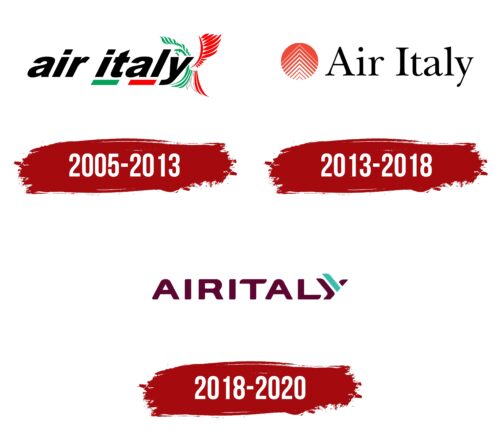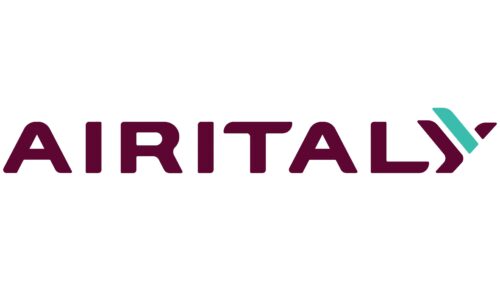Air Italy’s logo mirrors the company’s commitment to showcasing the Italian spirit in global air travel. It symbolizes the airline’s history of connecting Italy with destinations worldwide and its promise of distinctive services.
Air Italy: Brand overview
Air Italy, which began as Meridiana in 1963, tells a story of growth and change in the competitive world of aviation. 2005, the airline rebranded to Eurofly, focusing on vacation charter flights. The following year, it went public on the stock market.
In 2010, Eurofly and Meridiana merged to strengthen their position in Italy. But soon after, in 2011, they faced challenges and were bought out by the Aga Khan Fund for Economic Development.
Returning to the Meridiana name in 2013, the airline aimed to modernize and grow. This effort got a big boost in 2017 with an investment from Qatar Airways, which bought a 49% share.
2018 was a big year for the airline, now rebranded as Air Italy, with ambitious goals to become Italy’s leading airline and extend its services to North America, Canada, Africa, and Asia, making Milan a key hub.
However, the airline struggled and had to stop operations in February 2020, largely due to financial difficulties worsened by the pandemic.
Air Italy’s story shows the highs and lows of the aviation industry, emphasizing the need for flexibility and strength in the face of challenges. Its end highlights the unpredictable nature of the sector and leaves a legacy of lessons learned.
Meaning and History
Air Italy began as Meridiana, changing and growing through the years. It aimed to expand and improve, eventually rebranding itself as Air Italy, with big aspirations after investment from Qatar Airways. However, in 2020, the airline had to stop flying, showing just how challenging the airline business can be. This journey reflects the need for airlines to keep adapting to a fast-changing industry.
What is Air Italy?
Air Italy, registered as AIR ITALY S.p.A., became a privately owned Italian airline headquartered in Olbia, Sardinia. In 2019, the brand was the second-largest airline in Italy. The airline was a subsidiary of AQA Holding, owned by Alisarda (51%) and Qatar Airways (49%). The company operated briefly from 2018 to 2020, leaving a significant mark on the Italian aviation industry.
2005 – 2013
From 2005 to 2013, Air Italy unveiled its first logo featuring an eagle rising beside the airline’s name. The eagle, made up of rays and feathers, looks light and as if moving in the wind. The Italian flag inspires the colors, adding a sense of national pride, especially with the green, white, and red highlights around the letters.
The logo’s lowercase letters show Air Italy’s focus on being friendly and accessible to passengers. This design choice was part of a bigger shift towards better customer service. This change helped make Air Italy more popular in Italy, showing it as an airline that understands and meets its passengers’ needs.
2013 – 2018
Air Italy’s new logo is based on a simple geometric design featuring a circle that symbolizes the sun. With its warm orange color, this circle is meant to make passengers feel comfortable and hopeful about their trips. The logo isn’t just nice to look at; it shows Air Italy’s aim to provide a friendly and smooth travel experience.
Inside the circle, several angular stripes remind people of Meridiana, the company that bought Air Italy. By incorporating elements from Meridiana’s logo, Air Italy tried to create a stronger connection with its parent company. This was a big moment for Air Italy, especially since it became part of the Meridiana brand in 2013.
The logo uses black serif letters for its name, adding a touch of elegance and seriousness. This font style is similar to Meridiana’s, further linking the two brands. Even with these similarities, Air Italy retains some unique character.
2018 – 2020
In the Air Italy logo, the brand name seamlessly flows as one word, with the gap between “Air” and “Italy” precisely matching the spacing among the letters, fostering a sense of cohesion. The chosen font boldly merges sharp angles with gentle curves, lending the logo a contemporary and lively character. Each letter is rendered in a rich purple hue, infusing the brand’s visual identity with sophistication and distinctiveness. Additionally, the designers have incorporated a turquoise trapezoidal stripe within the letter “Y.” This stripe, aligning with the letter’s left diagonal, reimagines the “Y” as a depiction of a bird in ascent.
This artistic detail enriches the predominantly purple palette with a vibrant contrast while embodying a spirit of uplift and adventure, reflecting Air Italy’s high aspirations and the thrill associated with flight. Such integration highlights the airline’s identity, weaving together the concept of air travel with Italy’s renowned design sensibility and aesthetic elegance. As a result, the logo distinguishes itself through its visual appeal and symbolic portrayal of aviation, encapsulated within a single character, rendering Air Italy’s marque both engaging and unforgettable.
Font and Colors
The “AIRITALY” logo is set in a bold, uppercase sans-serif font that, with its minimalist, rounded design, is elegant and modern. The font’s clean lines and simplicity lend the logo a current and professional feel.
The letters are spaced uniformly, enhancing the logo’s sharpness and making it easy to read. The strong font reflects the brand’s distinct character. A standout feature is the “Y” in “ITALY,” which sports a turquoise diagonal stripe, giving a touch of dynamism to the otherwise straightforward lettering.
The color scheme showcases deep purple for the letters “AIRITAL” and a combination of the same purple and turquoise for the “Y,” providing a stark contrast. Deep purple is bold and spirited, setting the airline apart in an industry that typically favors blue and red. The turquoise in the “Y” imparts a sense of innovation and progress. This fresh and memorable color pairing helps the airline be noticed in the competitive market.
FAQ
What is the code for Air Italy?
Air Italy, also known as Air Italy S.p.A., was an airline that flew in and out of Italy to many places. This airline had special codes for different purposes, such as booking flights and managing operations.
The main code you’d see as a customer was IG, which Air Italy used for all booking-related stuff. You’d find this on your boarding pass or when you booked a flight online. Then, there was another code, ISS, which was more for the people flying the plane and those helping it land safely. This code helped with talking over the radio and ensuring everything went smoothly during the flight.
Air Italy also had a couple of numbers, 191, that they used behind the scenes. These numbers were important for dealing with money matters, like billing for flights or managing luggage and cargo. Air Italy was all about linking Italy to the rest of the world, and they focused on making their service top-notch.
Is Air Italy still operating?
Air Italy has stopped flying. It is used to connect places inside Italy and other countries. Now, it doesn’t offer flights anymore. People who want to travel to or from Italy must find different airlines. Air Italy’s shutdown means it won’t be part of the aviation world anymore, including the flight paths it used and the special experiences it gave to its passengers. If you are considering flying with Air Italy or have done so before, you’ll have to choose another airline for your trips.
What is the new name of Air Italy?
After merging with Air Italy in April 2013, the airline, once called Meridiana Fly, returned to its original name, Meridiana. This change was a key part of their plan to make the airline run smoother and stand out more among competitors. Meridiana has undergone many changes over the years, including updating its name and how it operates. This shows how airlines must keep up with changes to stay appealing to customers.
The merger was a big deal for Meridiana because it marked a new chapter in its growth, showing a strong desire to grow bigger in the airline world. They combined their resources, connections, and know-how to make a more robust airline that could handle flights within the country and internationally. Choosing to return to the name “Meridiana” was likely because it’s a name people know and trust, and it’s important for keeping a strong and welcoming image for loyal and new customers.
Who owns Air Italy?
AQA Holding S.p.A. owned Air Italy. This setup started on September 2, 2017, after Qatar Airways bought 49% of Meridiana, which was then renamed Air Italy. Alisarda, the company that started Meridiana, kept the other 51%.
This deal was big because it combined Qatar Airways’ international expertise with Alisarda’s knowledge of the Italian market. Alisarda kept over half of the company to ensure Air Italy stayed true to its Italian roots. The goal was to use Qatar Airways’ resources to grow Air Italy, update its planes, and improve what it offers to passengers. Having AQA Holding in charge meant Qatar Airways and Alisarda were serious about making Air Italy better and more competitive globally.







